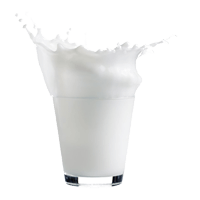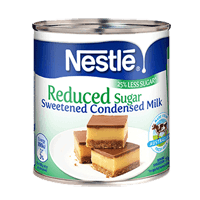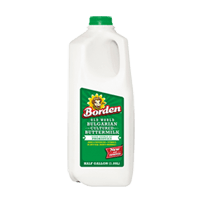Powdered Milk Nutrition & Health – Complete Data of All Nutrients
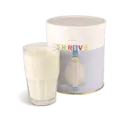
Introduction
Milk has been a prominent source of nutrients, especially protein, for humans for thousands of years. However, the perishable quality of milk makes it difficult to transport long distances or preserve for extensive periods. For this reason, humans have found ways to transform milk into more lasting products, such as powdered milk.
Powdered milk, also known as milk powder or dried milk, is a dairy product produced by evaporating water from milk. This article will discuss everything necessary regarding powdered milk based on scientific evidence.
Table of contents
Production
Milk powder is a dairy product from which the water has been removed to the greatest extent possible, thus creating hurdles in the growth of microorganisms. Dry milk production consists of the following processing steps - reception, clarification, cooling and storage, standardization, heat treatment, evaporation, homogenization, drying, and packaging (1).
The quality of powdered milk is significantly decided by the quality of the liquid milk from which it has been prepared. The reception process is about selecting the raw milk of a high standard.
The heat treatment rids the milk of any pathogens.
The two methods used today in industrially produced dry milk are spray-drying and roller-drying. Spray drying is the more popular option (1).
During manufacturing, some beneficial nutrients, such as vitamin A, vitamin D, and calcium, may be added to produce fortified powdered milk.
Storage Conditions
Milk powder should be stored in airtight containers; removing the air from the container before sealing it is recommended.
Powdered milk should be stored in a dry, dark, and cool space.
Powdered milk is recommended to be used within 6 months after opening for maximum freshness. However, different kinds of milk powders have different shelf lives.
When stored properly, the shelf life of whole milk powder is one year. Goat's milk powder can be kept from 6 months to a year, while organic whole milk powder can be stored for up to two years (2).
Varieties
The varieties of powdered milk are decided based on what kind of milk it has been made from and what processing method has been used.
Powdered milk made from non-fat or skim milk is accordingly named non-fat dry milk or skim milk powder and contains less than 1.5% fat by weight. Similarly, powdered milk made from whole milk is called whole milk powder and consists of 26 to 40% fats. While non-fat and skim milk powders have the same fat content, unlike skim milk powder, non-fat milk powder also has a required minimum protein content of 34%.
Skim and non-fat milk powders can also be classified depending on their processing methods: high-heat (least soluble), medium-heat, and low-heat (most soluble) (3).
Depending on the kind of milk used, dry milk can be cow's milk powder, goat's milk powder, camel's milk powder, and so on. However, the most common milk powder found in the stores is made from cow milk.
Different powdered milk can also be made by removing water from other dairy products, such as yogurt and buttermilk.
Nutrition
The nutritional values in this article are presented for whole, dry milk without added vitamin D.
Macronutrients and Calories
Powdered milk is naturally high in nutrients and contains a low percentage of water. Powdered milk contains only 2.47% water.
Dry milk does not have a set average serving size by the Food and Drug Administration. However, adding one cup of water to a quarter cup of dry milk can substitute for cup of liquid milk. This article will present values of nutrients focusing on an average serving size of a quarter cup or 32g of powdered milk.
Macronutrients chart
Calories
Dry milk can be considered a high-calorie food, as a quarter cup of powdered milk provides 159 calories.
At the same time, a cup of low-fat milk contains only 103 calories, while a cup of whole-fat milk has 152 calories (4).
Protein
Milk is famously an excellent source of protein. Powdered milk is no exception. A quarter cup of dry milk provides 8.42g of protein.
Similarly, a cup of whole milk provides 8.2g of protein. Overall, milk and dry milk have a similar protein composition.
The protein found in milk is considered a complete protein, meaning it is of high quality as it provides high levels of all essential amino acids.
Powdered milk contains relatively lower levels of methionine and phenylalanine while rich in tryptophan, threonine, and isoleucine.
The chief protein in milk is called casein. Casein is a family of poorly soluble proteins bound to phosphorus and calcium that make up 70 to 80% of the protein found in cow milk. Casein is also responsible for the color of milk (5).
The other 20% of protein is made up of so-called whey protein. This is a family of soluble, globular proteins, including beta-lactoglobulin, alpha-lactoglobulin, and serum albumin. Whey is also rich in vitamins and minerals (5).
Protein quality breakdown
Fats
A quarter-cup serving of powdered milk contains 8.54g of fats. In comparison, one serving size of low-fat milk contains only 2.4g, of fats, and one cup of whole-fat milk provides 8g of fats.
The fat content of powdered milk is made up predominantly of saturated fat. In every quarter cup of dry milk, 5.34g of saturated fat can be found. This means that saturated fat makes up 63% of the fats in powdered milk.
Saturated fatty acids are more harmful than unsaturated fats. The U.S. Dietary Guidelines recommend restricting saturated fat intake to less than 10% of calories to reduce the risk of cardiovascular disease (6).
A quarter cup of powdered milk also contains 2.53g of monounsaturated fats and only 0.2g of polyunsaturated fatty acids.
Powdered milk contains 31g of cholesterol per quarter-cup serving. One cup of low-fat milk contains only 12g of cholesterol, while 30g can be found in whole-fat milk.
Fat type information
Carbohydrates
A quarter-cup serving of powdered milk provides 12.3g of carbohydrates. 100% of these fats are sugars, specifically lactose, as dry milk contains no dietary fiber.
For comparison, low-fat milk contains 12.7g of carbohydrates, and whole-fat milk has 12g of carbohydrates, all made up of lactose.
Lactose is a sugar that can be found only in milk products. It is a disaccharide, meaning it is composed of two simple sugar molecules - glucose and galactose. Lactose intolerance is a common digestive disorder when the body cannot break down lactose into glucose and galactose. More information about this can be found in the "Health Impact" section.
Vitamins
Powdered milk is very dense in nutrients. It is in the top 10% of foods as a source of vitamin B2 and in the top 20% as a source of vitamin A.
Powdered milk is an excellent source of vitamins B12, C, B5, and B1. Ample amounts of folate, vitamin B6, vitamin D, vitamin E, vitamin K, and vitamin B3 can also be found in dry milk.
In short, powdered milk has no lack of vitamins.
Liquid milk tends to have higher levels of most vitamins. However, dry milk is relatively richer in folate and vitamin E.
Vitamin coverage chart
Minerals
Powdered milk is also a great source of minerals, especially calcium, phosphorus, and potassium. Dry milk is in the top 5% of foods as a source of calcium and in the top 6% of foods as a source of potassium.
Powdered milk provides high levels of magnesium and zinc as well.
Dry milk contains sufficient levels of selenium, copper, manganese, iron, and choline.
Dry milk is high in sodium, containing 119mg per quarter-cup serving. Powdered milk is higher in sodium than low-fat or whole-fat milk.
Mineral coverage chart
Glycemic Index
Without added carbohydrate sources, whole milk powder has glycemic index values similar to standard liquid whole milk (7). Standard liquid milk has a low glycemic index of 31 (8).
The glycemic index of powdered milk has been calculated to fall from 23±4 to 68±6, depending on the amount of added carbohydrates. Products containing maltodextrins, corn, or glucose syrups increase the glycemic index by more than 2-fold and glycemic load by 7-fold compared to milk powders with no added carbohydrates (7).
The glycemic load of milk powder ranges from 3 to 18.
Powdered milk, with no added carbohydrates, has a low glycemic index while adding carbohydrates can significantly raise the glycemic index value of dry milk.
Milk products, including milk powder, produce a high insulin response while having a low glycemic index due to their specific protein composition (9).
Acidity
The acidity of powdered milk is close to neutral, with the pH value falling from 6.6 to 6.8. No significant variation can be seen among different powder milk brands (10).
Similarly, the normal range of pH for milk is 6.5 to 6.7.
The acidity of foods can also be demonstrated by looking at their potential renal acid load or PRAL values. This value shows how much acid or base the food produces inside the gastrointestinal tract.
The PRAL value for powdered milk has been calculated to be -0.4. This shows that powdered milk is only slightly alkaline-forming.
Weight Loss & Diets
Whole powdered milk is high in calories, fats, and carbohydrates. One quarter-cup serving of whole dry milk provides 159 calories. At the same time, a quarter-cup serving of non-fat dry milk is significantly lower in fats and contains 113 calories (11).
Non-fat, skim, or low-fat powdered milk is better for low-fat or low-calorie diets.
Despite the high-calorie content, non-fat dry milk has been researched to help reduce weight gain and associated fatty tissue inflammation in diet-induced obese rats (12).
There is little evidence to support a concern to limit the consumption of milk and other dairy products for children because they may promote obesity (13).
| Keto | A keto diet allows up to 20 to 30g of carbohydrate daily. One quarter-cup serving of powdered milk contains 12.3g of carbohydrates. This means powdered milk is not advisable on a keto diet and should only be used in strict moderation. |
| DASH | A DASH diet, aiming to lower blood pressure, focuses on low-fat or fat-free dairy products. Powdered milk is often high not only in fats but also in sodium. One quarter-cup serving of dry milk contains 119mg of sodium. Therefore, powdered milk, especially whole-fat, should be avoided on a DASH diet. However, some research found that fortified powdered milk reduces blood pressure (16). |
| Atkins | Dry or liquid milk is prohibited in Phase 1 of the Atkins diet or the Induction phase. You can start using whole or powdered milk starting from Phase 2, but only in moderation and without added carbohydrates (14). |
| Mediterranean | A traditional Mediterranean diet includes low to moderate consumption of dairy products - usually cheese and yogurt. Powdered milk is not advisable to use on a Mediterranean diet. Dry milk with added carbohydrates should especially be avoided. |
| Paleo | A strict paleo diet excludes dairy products, especially when processed, from the acceptable foods list. However, some people incorporate whole-fat milk into their paleo diets. Naturally, powdered milk was not eaten during the Paleolithic era; however, whether or not to use powdered milk on a paleo diet is a personal choice. |
| Vegan/ Vegetarian/ Pescetarian | As a dairy product, powdered milk naturally fits into a vegetarian and pescetarian diet but not a vegan one. |
| Gluten-free | Powdered milk is a gluten-free product. |
| Dukan | While non-fat milk powder can be consumed in moderation during the Attack phase, it is not recommended. |
| Intermittent Fasting | Like most foods, dry milk can be used during eating but should be avoided during fasting. |
| Low Fat & Low Calorie | Non-fat or low-fat powdered milk can fit in a low-fat diet, while whole-fat dry milk does not. However, non-fat and whole-fat dry milk are high-calorie foods and do not fit in a low-calorie diet. |
| Low Carb | One quarter-cup serving size of whole dry milk contains 12g of carbohydrates. Therefore, powdered milk is not suitable for a low-carb diet. |
| Anti Inflammatory | Research has suggested that pasteurized and powdered milk, as well as fermented dairy products, display an anti-inflammatory effect, particularly on oral fibroblasts and oral epithelial cells (15). This implies that powdered milk can be used on an anti-inflammatory diet. |
| BRAT | Milk and dairy, including powdered milk, should be avoided on a BRAT diet, as consumption may worsen diarrhea. |
Health Impact
As powdered milk has nearly the same nutritional properties as liquid milk, it also has very similar impacts on health, both positive and negative.
Health Benefits
Cardiovascular Health
Milk powder presents an excellent opportunity to add missing micronutrients to an everyday diet. Research has shown that together with other preventive interventions, consuming milk powder fortified with potassium and phytosterols represents a cost-effective strategy to attenuate the rapid increase in cardiovascular burden in various countries (16, 17).
Fortified milk powder may reduce the risk of cardiovascular disease by reducing blood pressure and low-density lipoprotein levels. Overall, dairy product consumption, except for butter, has also been shown to decrease arterial stiffness and lower the risk of stroke (16).
Despite the high saturated fat content of whole milk or whole powdered milk, research has implied that dairy consumption induces a positive or neutral effect on human cardiovascular health (18).
Diabetes
Milk powder, supplemented with insulin and resistant dextrin, has been researched to help improve glycemic control, insulin resistance, and blood pressure in elderly patients with type 2 diabetes mellitus (19).
One study identified unique compounds, namely oxylipins and endocannabinoids, in the blood plasma of diet-induced obese rats fed a diet rich in non-fat milk powder high in calcium. These rats displayed decreased adiposity, markedly reduced fatty change, lower fat tissue inflammation, and improved glucose homeostasis (20).
Dairy consumption, including powdered milk consumption, even in moderate amounts, has been associated with a decreased risk of developing type 2 diabetes mellitus and favorable changes in waist circumference, body mass index, and blood pressure (21).
Camel milk powder has also been studied as a potential functional food to help prevent type 2 diabetes mellitus (22).
Bone Health
Dairy products are famously high in calcium and essential for bone health. High dairy consumption can help maintain dental health and prevent osteoporosis.
Postmenopausal women are at a high risk of developing osteoporosis due to hormonal changes. Consumption of high-calcium milk powder effectively reduces bone loss at the lumbar spine among healthy postmenopausal women. Supplementing high-calcium milk powder also reduced height loss (23).
Supplementation with milk powder is also effective in enhancing bone growth in children (24).
However, milk powder supplementation in healthy pubertal adolescents may not significantly affect bone turnover and mineralization (25).
Cancer
Studies have not concluded definitively about the association between dairy consumption and cancer risk.
Research has found an inverse association between milk consumption and the risk of colorectal and bladder cancer (26).
Casein is the major protein in milk powder and can display comparative anticancer activity. Whey-containing diets have also reduced colon and mammary cancers in laboratory animals (27).
Research has concluded that harm for ordinary people could only occur with excessive consumption rather than regular moderate daily intake, as advised by nutritionists. Products that are grossly and illegally contaminated with environmental pollutants or specific toxicants could also cause harm to human health (27).
Downsides and Risks
Lactose Intolerance
Lactose intolerance is a decreased ability to digest the primary sugar found in milk and milk powder - lactose. It is a common digestive disorder among adults. The disorder is caused by a lack of an enzyme in the small intestine called lactase, which usually breaks down lactose into glucose and galactose.
Common symptoms of lactose intolerance are diarrhea, bloating, nausea, and stomach cramps after consuming dairy products.
Most people with lactose intolerance are born producing enough lactase but lose the ability to do so as they grow into adulthood. This is a genetic lactase deficiency called primary lactose intolerance.
Lactose intolerance can also develop due to injury or a disease, such as Crohn's disease, celiac disease, or intestinal infections. This is called secondary lactose intolerance.
Rarely can a genetic defect cause congenital lactose intolerance.
Milk Allergy
Despite the common misconception, lactose intolerance and milk allergy are different. Milk allergy is an overreaction from the immune system towards particles found in milk and dairy products made from milk.
Milk allergy is one of the most common allergies found in children. However, most of these children overgrow their milk allergy before age 16 (28).
Symptoms of a milk allergy include hives, nausea and vomiting, abdominal cramps, bloody stools, and, in rare cases, anaphylaxis.
The cause of milk allergy is often one or both proteins found in cow milk - casein and whey. Children allergic to cow's milk may also react to sheep's, goat's, or soy's.
Cancer
Certain compounds decrease in content during milk processing into powder milk, while other compounds may be added.
Heat treatments and homogenization of milk cause the oxidation of valuable anticancer-conjugated linoleic acid through exposure to high temperatures and high pressures and the reduction of fat globule size (27).
Products of cholesterol oxidation are found in dairy products. However, the content of cholesterol oxidation products in milk and dairy is minimal. The formation of cholesterol oxidation products in milk and dairy can only occur under harsh conditions, such as applying high heating temperatures for an extended period, long storage at high temperatures, and foods in a dehydrated state or low water activities (27).
Powdered milk contains oxidized cholesterol, which further contributes to oxidative stress. Cholesterol oxidation products have many adverse biological effects, such as atherogenic, cytotoxic, mutagenic, and carcinogenic (27).
Certain studies have also found a positive association between diets high in calcium and the risk of prostate cancer (26).
History
In the thirteenth century, Marco Polo reported that soldiers of Kublai Khan carried dried milk on excursions. It is said that part of the fat was removed from the milk before drying, and dehydration was achieved by solar heating.
The first usable commercial production of milk powder was invented by the Russian chemist M. Dirchoff in 1832. In 1850, Birdseye concentrated milk with added sugar until a solid was obtained. In 1855, T. S. Grimwade filed a patent on drying milk, though William Newton had patented a vacuum-drying process as early as 1837.
The real beginning of the concentrated and dried dairy product industry began in the nineteenth century when Nicolas Appert, a French inventor, described his procedure for concentrating and drying milk. 1909 Nicolas Appert developed dried milk in tablet form by air-drying milk solids concentrated to a "dough" consistency. During the second half of the nineteenth century, attempts were made to produce dried milk, which involved adding other dry products to concentrated milk. Sugar, cereal products, and sodas were added singly or in combinations (1).
Appearance
Regular dry whole milk is light yellow but varies reasonably with the color of the fat from a creamy white to a deep yellow (1). Wrongly stored or manufactured dry milk can be darker or lighter in color:
- Browned or darkened: A distinct brown replaces the standard creamy color when this defect is present. This defect is usually associated with an old, stale flavor.
- Scorched: Discoloration due to the browning of the milk solids is usually associated with the roller-drying process. The powder may vary from light to dark brown.
- Lack of uniformity: This defect may be due to either partial discoloration after packaging or partial scorching during manufacturing (1).
The product should be free-flowing to some extent and with no lumps. Lumpy milk powder lacks homogeneity. This defect is found frequently in the spray process product. Lumps form due to insufficient drying, dripping from spray nozzles, or exposure to moisture-laden air. Hard lumps can range in size from a grain of wheat upward (1).
Rarely, dry milk can also lose its powdery consistency and become rock-solid. In this case, milk solids have lost their value for human consumption (1).
Taste
After adding water, whole dry milk should have a pleasant, clean, rich, sweet, and fresh flavor. Reconstituted powder milk tends to have a milder taste than regular milk. However, whole-fat powder milk has a more robust flavor than non-fat or low-fat dry milk.
Defects in taste may result from poor quality ingredients, wrong manufacturing or drying methods, and incorrect storage conditions (1). Common flavor defects are:
- Stale: This is a characteristic age defect associated with protein. This defect closely resembles the musty flavor typical of casein. When the defect is intense, it may be accompanied by a darkening of the product. This defect is observed in dry milk after storage for nine months.
- Rancid: Rancid whole milk powder has a bitter, soapy, unclean taste, which is persistent after the sample has been chewed up and spit out. The reason may be insufficient temperature used for prior warming and the lipase enzyme that remains active and causes rancidity.
- Oxidized or tallow is milk powder's most troublesome flavor defect. Many factors are responsible for developing this defect, such as temperature, light, moisture, acidity, metallic salts, condensation, and type of packaging.
- Scorched: This flavor is produced in products subjected to excessive heat during the drying stage or permitted to remain in the drying chamber for too long. It is usually accompanied by many scorched specks in the product and sometimes by a dark discoloration typical of overheating (1).
Use
Powdered milk is often rehydrated back into liquid form by adding water. However, it can also be used dry in various recipes, especially baking.
Ingredients can be added to powdered milk and water to get chocolate, vanilla, or strawberry milk.
While the amount of water used for reconstituting milk can be an individual decision based on preference, a quarter cup of milk powder is usually used with one cup of water to rehydrate the dry milk.
Powdered milk can also make other dairy products, such as sweetened condensed milk, evaporated milk, yogurt, and cheese.
Dry milk is an essential ingredient in a sweet called gulab jamun, popular in South and Southeast Asia. Gulab jamun is made by mixing ingredients into a dough, forming it into balls, deep-frying, and dropping it into simmering sugar syrup.
References
- https://www.researchgate.net/publication/286454833
- https://www.fromnaturewithlove.com/library/storagemilkpowders.asp
- https://www.adpi.org/DairyProducts/DryMilks/SkimMilkPowder/tabid/359/Default.aspx
- https://fdc.nal.usda.gov/fdc-app.html#/food-details/746782/nutrients
- https://www.ncbi.nlm.nih.gov/pmc/articles/PMC3905294/
- https://www.sciencedirect.com/science/article/pii/S0735109720356874
- https://www.ncbi.nlm.nih.gov/pmc/articles/PMC3571636/
- https://academic.oup.com/ajcn/article/114/5/1625/6320814
- https://pubmed.ncbi.nlm.nih.gov/15531672/
- https://pdfs.semanticscholar.org/8271/fa3efa5ab2a21ec9c1588f0318b0bdd71ce6.pdf
- https://fdc.nal.usda.gov/fdc-app.html#/food-details/171273/nutrients
- https://pubmed.ncbi.nlm.nih.gov/22269778/
- https://www.ncbi.nlm.nih.gov/pmc/articles/PMC6536827/
- https://au.atkins.com/static/default/files/documents/pdf/Atkins%20Food%20List.pdf
- https://pubmed.ncbi.nlm.nih.gov/30238412/
- https://www.ncbi.nlm.nih.gov/pmc/articles/PMC6627836/
- https://www.ncbi.nlm.nih.gov/pmc/articles/PMC5623478/
- https://www.ncbi.nlm.nih.gov/pmc/articles/PMC5867544/
- https://pubmed.ncbi.nlm.nih.gov/30346655/
- https://nutritionandmetabolism.biomedcentral.com/articles/10.1186/1743-7075-11-24
- https://care.diabetesjournals.org/content/37/1/56
- https://onlinelibrary.wiley.com/doi/full/10.1002/fsn3.2420
- https://pubmed.ncbi.nlm.nih.gov/25626413/
- https://pubmed.ncbi.nlm.nih.gov/15095035/
- https://link.springer.com/article/10.1007/s00198-019-05105-4
- https://pubmed.ncbi.nlm.nih.gov/22081693/
- https://onlinelibrary.wiley.com/doi/full/10.1111/1541-4337.12011
- Milk Allergy Symptoms, Management and Treatment
Important nutritional characteristics for Powdered milk

|
Glycemic index ⓘ
Source:
Check out our Glycemic index chart page for the full list.
|
32 (low) |
| Insulin index ⓘ https://www.mdpi.com/2072-6643/5/1/23/htm | 75-95 |
| Calories ⓘ Calories per 100-gram serving | 496 |
| Net Carbs ⓘ Net Carbs = Total Carbohydrates – Fiber – Sugar Alcohols | 38.42 grams |
| Acidity (Based on PRAL) ⓘ PRAL (Potential renal acid load) is calculated using a formula. On the PRAL scale the higher the positive value, the more is the acidifying effect on the body. The lower the negative value, the higher the alkalinity of the food. 0 is neutral. | -0.4 (alkaline) |
| Oxalates ⓘ Animal products do not contain oxalate. | 0mg |
Powdered milk calories (kcal)
| Serving Size | Calories | Weight |
|---|---|---|
| Calories in 100 grams | 496 | |
| Calories in 1 cup | 635 | 128 g |
| Calories in 0.25 cup | 159 | 32 g |
Powdered milk Glycemic index (GI)
Mineral chart - relative view
Vitamin chart - relative view
Fiber content ratio for Powdered milk
All nutrients for Powdered milk per 100g
| Nutrient | Value | DV% | In TOP % of foods | Comparison |
| Calories | 496kcal | 25% | 7% |
10.6 times more than Orange
|
| Protein | 26.32g | 63% | 10% |
9.3 times more than Broccoli
|
| Fats | 26.71g | 41% | 9% |
1.2 times less than Cheddar Cheese
|
| Vitamin C | 8.6mg | 10% | 25% |
6.2 times less than Lemon
|
| Net carbs | 38.42g | N/A | 23% |
1.4 times less than Chocolate
|
| Carbs | 38.42g | 13% | 24% |
1.4 times more than Rice
|
| Cholesterol | 97mg | 32% | 12% |
3.8 times less than Egg
|
| Vitamin D | 0.5µg | 5% | 48% |
4.4 times less than Egg
|
| Iron | 0.47mg | 6% | 78% |
5.5 times less than Beef broiled
|
| Calcium | 912mg | 91% | 5% |
7.3 times more than Milk
|
| Potassium | 1330mg | 39% | 6% |
9 times more than Cucumber
|
| Magnesium | 85mg | 20% | 16% |
1.6 times less than Almond
|
| Sugar | 38.42g | N/A | 26% |
4.3 times more than Coca-Cola
|
| Fiber | 0g | 0% | 100% |
N/A
|
| Copper | 0.08mg | 9% | 63% |
1.8 times less than Shiitake
|
| Zinc | 3.34mg | 30% | 28% |
1.9 times less than Beef broiled
|
| Phosphorus | 776mg | 111% | 8% |
4.3 times more than Chicken meat
|
| Sodium | 371mg | 16% | 28% |
1.3 times less than White Bread
|
| Vitamin A | 934IU | 19% | 20% |
17.9 times less than Carrot
|
| Vitamin A RAE | 258µg | 29% | 24% | |
| Vitamin E | 0.58mg | 4% | 54% |
2.5 times less than Kiwifruit
|
| Selenium | 16.3µg | 30% | 51% | |
| Manganese | 0.04mg | 2% | 68% | |
| Vitamin B1 | 0.28mg | 24% | 28% |
1.1 times more than Pea raw
|
| Vitamin B2 | 1.21mg | 93% | 10% |
9.3 times more than Avocado
|
| Vitamin B3 | 0.65mg | 4% | 75% |
14.8 times less than Turkey meat
|
| Vitamin B5 | 2.27mg | 45% | 28% |
2 times more than Sunflower seed
|
| Vitamin B6 | 0.3mg | 23% | 39% |
2.5 times more than Oat
|
| Vitamin B12 | 3.25µg | 135% | 22% |
4.6 times more than Pork
|
| Vitamin K | 2.2µg | 2% | 64% |
46.2 times less than Broccoli
|
| Folate | 37µg | 9% | 39% |
1.6 times less than Brussels sprout
|
| Saturated Fat | 16.74g | 84% | 7% |
2.8 times more than Beef broiled
|
| Monounsaturated Fat | 7.92g | N/A | 20% |
1.2 times less than Avocado
|
| Polyunsaturated fat | 0.67g | N/A | 55% |
70.9 times less than Walnut
|
| Tryptophan | 0.37mg | 0% | 44% |
1.2 times more than Chicken meat
|
| Threonine | 1.19mg | 0% | 49% |
1.7 times more than Beef broiled
|
| Isoleucine | 1.59mg | 0% | 43% |
1.7 times more than Salmon raw
|
| Leucine | 2.58mg | 0% | 44% |
1.1 times more than Tuna Bluefin
|
| Lysine | 2.09mg | 0% | 55% |
4.6 times more than Tofu
|
| Methionine | 0.66mg | 0% | 54% |
6.9 times more than Quinoa
|
| Phenylalanine | 1.27mg | 0% | 44% |
1.9 times more than Egg
|
| Valine | 1.76mg | 0% | 42% |
1.2 times less than Soybean raw
|
| Histidine | 0.71mg | 0% | 58% |
Equal to Turkey meat
|
| Omega-3 - EPA | 0g | N/A | 100% |
N/A
|
| Omega-3 - DHA | 0g | N/A | 100% |
N/A
|
| Omega-3 - DPA | 0g | N/A | 100% |
N/A
|
Check out similar food or compare with current
NUTRITION FACTS LABEL
Serving Size ______________
Health checks
Powdered milk nutrition infographic
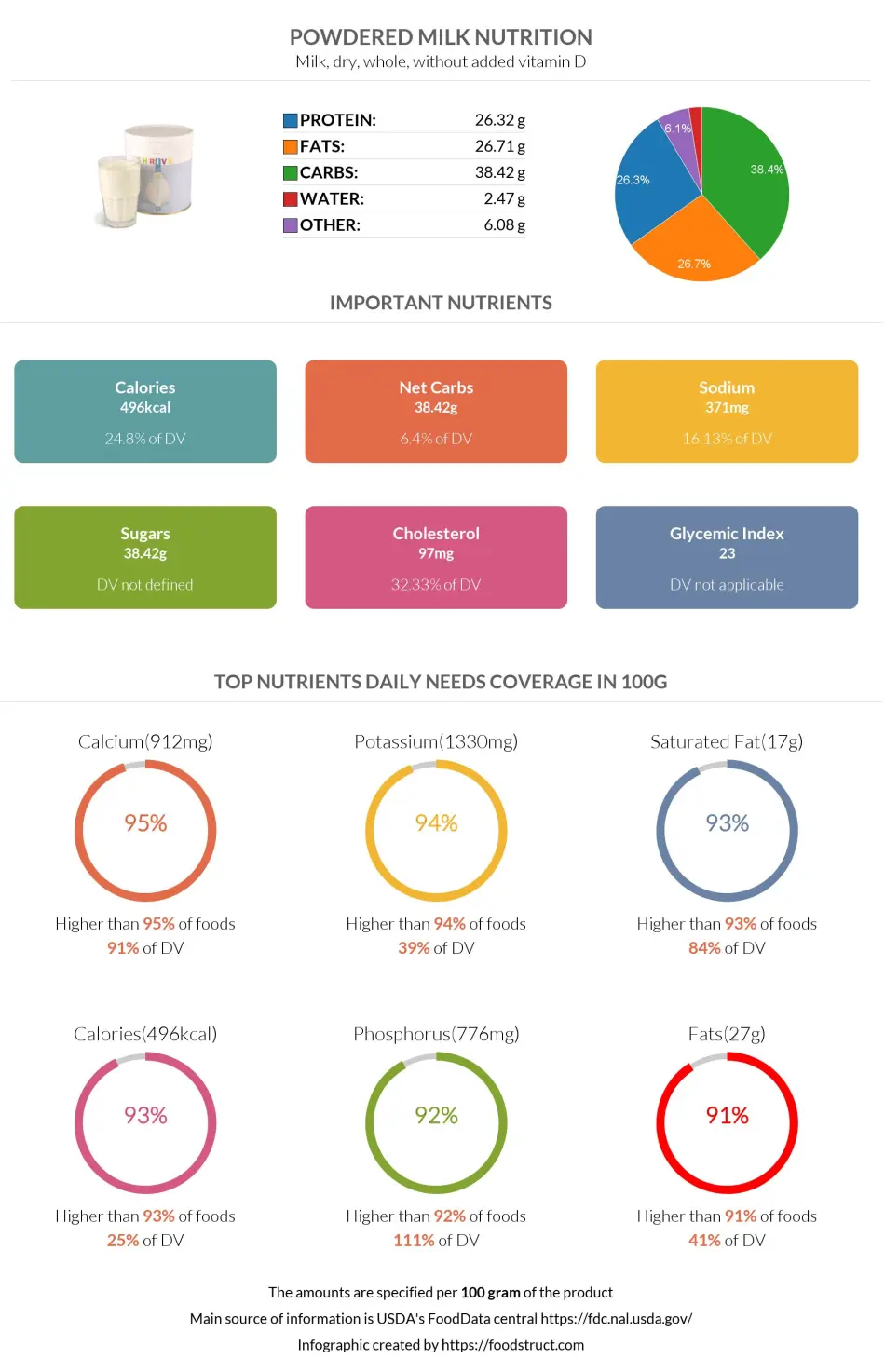
References
All the values for which the sources are not specified explicitly are taken from FDA’s Food Central. The exact link to the food presented on this page can be found below.

